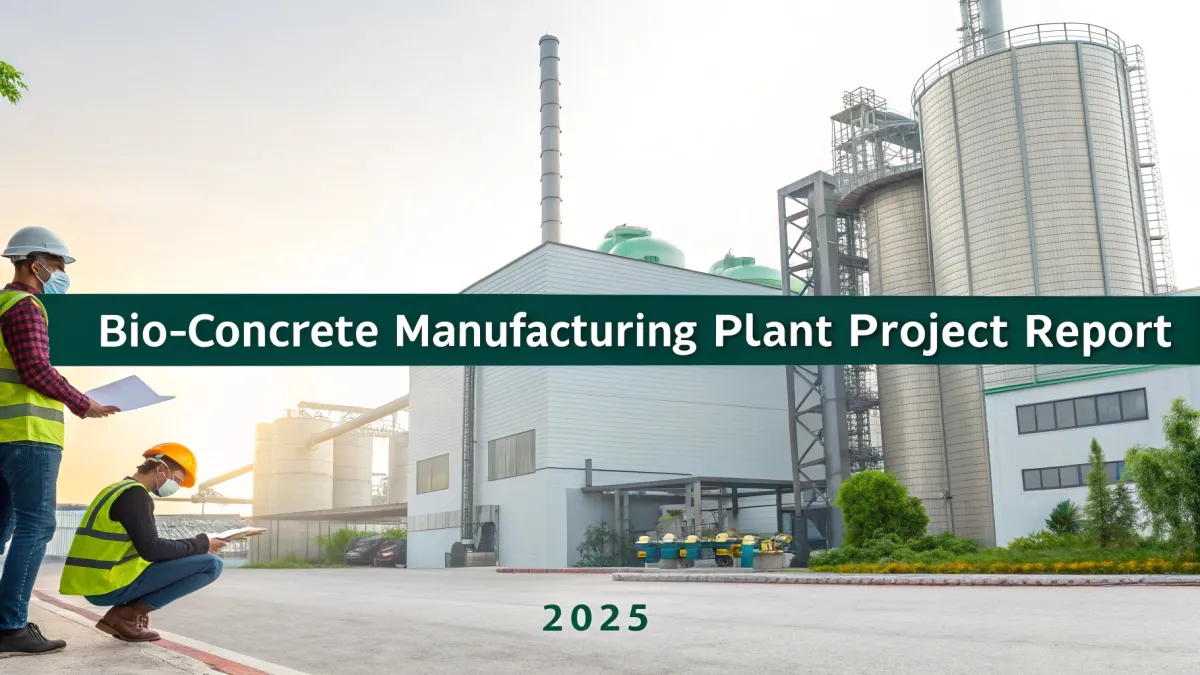
Setting Up A Bio-Concrete Manufacturing Plant 2025: Cost Analysis And Raw Materials Requirement
IMARC Group's report titled“ Bio-Concrete Manufacturing Plant Project Report 2025: Industry Trends, Plant Setup, Machinery, Raw Materials, Investment Opportunities, Cost and Revenue ” offers a comprehensive guide for establishing a bio-concrete manufacturing plant, covering everything from product overview and production processes to detailed financial insights.
Bio-concrete, also known as self-healing concrete, is an innovative construction material designed to automatically repair cracks using biological processes. It incorporates special bacteria, such as Bacillus species, along with nutrients like calcium lactate into the concrete mix. When cracks form and water seeps in, the dormant bacteria become active and produce limestone, which fills the cracks and restores the material's integrity. This process significantly extends the lifespan of structures, reduces maintenance costs, and improves sustainability. Bio-concrete is increasingly seen as a breakthrough in modern construction due to its durability and eco-friendly characteristics.
The bio-concrete industry is gaining traction due to growing global emphasis on sustainable construction materials and infrastructure resilience. Rising demand for smart and eco-friendly building solutions is driving adoption, as bio-concrete reduces the need for frequent repairs and lowers long-term costs. Increasing urbanization and rapid infrastructure development worldwide are fueling interest in advanced building materials that enhance structural durability. Governments and regulatory bodies promoting green construction practices are also supporting its adoption. Additionally, ongoing research and technological advancements in microbiology and material science are making bio-concrete more cost-effective and commercially viable. The push toward reducing carbon footprints in construction and the rising cost of maintenance in aging infrastructure are further accelerating industry growth. Emerging markets in Asia-Pacific and the Middle East are expected to contribute significantly, as large-scale infrastructure projects in these regions increasingly prioritize durability, sustainability, and innovation in building materials.
Request for a Sample Report : https://www.imarcgroup.com/bio-concrete-manufacturing-plant-project-report/requestsample
Key Steps Required to Set Up a Bio-Concrete Plant .
Market AnalysisThe report provides insights into the landscape of the bio-concrete industry at the global level. The report also provides a segment-wise and region-wise breakup of the global bio-concrete industry. Additionally, it also provides the price analysis of feedstocks used in the manufacturing of bio-concrete, along with the industry profit margins.
-
Segment Breakdown
Regional Insights
Pricing Analysis and Trends
Market Forecast
Detailed information related to the process flow and various unit operations involved in the bio-concrete manufacturing plant project is elaborated in the report. These include:
-
Land, Location, and Site Development
Plant Layout
Plant Machinery
Raw Material Procurement
Packaging and Storage
Transportation
Quality Inspection
Utilities
Human Resource Requirements and Wages
Marketing and Distribution
Request for Customized Report:
https://www.imarcgroup.com/request?type=report&id=14684&flag=E Project Requirements and CostThe report provides a detailed location analysis covering insights into the plant location, selection criteria, location significance, environmental impact, and expenditure for bio-concrete manufacturing plant setup. Additionally, the report also provides information related to plant layout and factors influencing the same. Furthermore, other requirements and expenditures related to machinery, raw materials, packaging, transportation, utilities, and human resources have also been covered in the report.
Machinery and Equipment
-
List of machinery needed for bio-concrete production
Estimated costs and suppliers
Raw Material Costs
-
Types of materials required and sourcing strategies
Utilities and Overheads
-
Electricity, water, labor, and other operational expenses
A detailed analysis of the project economics for setting up a bio-concrete manufacturing plant is illustrated in the report. This includes the analysis and detailed understanding of capital expenditure (CAPEX), operating expenditure (OPEX), income projections, taxation, depreciation, liquidity analysis, profitability analysis, payback period, NPV, uncertainty analysis, and sensitivity analysis.
Capital Expenditure (CAPEX)
-
Initial setup costs: land, machinery, and infrastructure
Operating Expenditure (OPEX)
-
Recurring costs: raw materials, labor, maintenance
Revenue Projections
-
Expected income based on production capacity, target market, and market demand
Financial Analysis
-
Liquidity Analysis
Profitability Analysis
Payback Period
Net Present Value (NPV)
Internal Rate of Return
Profit and Loss Account
-
Licenses and Permits
Regulatory Procedures and Approval
Certification Requirement
-
Total human resource requirement
Salary cost analysis
Employee policies overview
The report also covers critical insights into key success and risk factors, which highlight the aspects that influence the success and potential challenges in the industry. Additionally, the report includes strategic recommendations, offering actionable advice to enhance operational efficiency, profitability, and market competitiveness. A comprehensive case study of a successful venture is also provided, showcasing best practices and real-world examples from an established business, which can serve as a valuable reference for new entrants in the market.
About Us:
IMARC is a global market research company offering comprehensive services to support businesses at every stage of growth, including market entry, competitive intelligence, procurement research, regulatory approvals, factory setup, company incorporation, and recruitment. Specializing in factory setup solutions, we provide detailed financial cost modeling to assess the feasibility and financial viability of establishing new manufacturing plants globally. Our models cover capital expenditure (CAPEX) for land acquisition, infrastructure, and equipment installation while also evaluating factory layout and design's impact on operational efficiency, energy use, and productivity. Our holistic approach offers valuable insights into industry trends, competitor strategies, and emerging technologies, enabling businesses to optimize operations, control costs, and drive long-term growth.
Contact Us:
IMARC Group
134 N 4th St. Brooklyn, NY 11249, USA
Email: sales[@]imarcgroup.com
Tel No:(D) +91 120 433 0800
United States: (+1-201971-6302)
Legal Disclaimer:
MENAFN provides the
information “as is” without warranty of any kind. We do not accept
any responsibility or liability for the accuracy, content, images,
videos, licenses, completeness, legality, or reliability of the information
contained in this article. If you have any complaints or copyright
issues related to this article, kindly contact the provider above.


















Comments
No comment